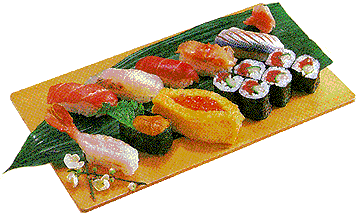Posted by Japanese Food in
1 komentar
 Long time no see!!
Long time no see!!This is my first posting in 2011, so dont miss it!
A wide variety of ramen exists in Japan, with geographical and vendor-specific differences even in varieties that share the same name. Ramen can be broadly categorized by its two main ingredients: noodles and broth.
Noodles
 Most noodles are made from four basic ingredients: wheat flour, salt, water, and kansui, which is essentially a type of alkaline mineral water, containing sodium carbonate and usually potassium carbonate, as well as sometimes a small amount of phosphoric acid. Originally, kansui was named after the water from Inner Mongolia's Lake Kan which contained large amounts of these minerals and was said to be perfect for making these noodles.
Most noodles are made from four basic ingredients: wheat flour, salt, water, and kansui, which is essentially a type of alkaline mineral water, containing sodium carbonate and usually potassium carbonate, as well as sometimes a small amount of phosphoric acid. Originally, kansui was named after the water from Inner Mongolia's Lake Kan which contained large amounts of these minerals and was said to be perfect for making these noodles.Making noodles with kansui lends them a yellowish hue as well as a firm texture. For a brief time after World War II, low-quality tainted kansui was sold, though kansui is now manufactured according to JAS standards. Eggs may also be substituted for kansui. Some noodles are made with neither eggs nor kansui and should only be used for yakisoba.Ramen noodles come in various shapes and lengths. They may be fat, thin, or even ribbon-like, as well as straight or wrinkled.
Soup
 Ramen soup is generally made from stock based on chicken or pork, combined with a variety of ingredients such as kombu (kelp), katsuobushi (skipjack tuna flakes), niboshi (dried baby sardines), beef bones, shiitake, and onions, and then flavored with salt, miso, or soy sauce. Other styles that have emerged later on include curry ramen and other flavors.
Ramen soup is generally made from stock based on chicken or pork, combined with a variety of ingredients such as kombu (kelp), katsuobushi (skipjack tuna flakes), niboshi (dried baby sardines), beef bones, shiitake, and onions, and then flavored with salt, miso, or soy sauce. Other styles that have emerged later on include curry ramen and other flavors.The resulting combination is generally divided into four categories (although new and original variations often make this categorisation less clear-cut):
- Shio ("salt") ramen is probably the oldest of the four and, like the Chinese maotang (毛湯). It is the lightest ramen, a pale, clear, yellowish broth made with plenty of salt and any combination of chicken, vegetables, fish, and seaweed. Occasionally pork bones are also used, but they are not boiled as long as they are for tonkotsu ramen, so the soup remains light and clear. Shio is generally the healthiest kind of ramen; fat content tends to be low, and fresh vegetables like cabbage, leeks, onions, and bamboo shoots typically adorn the simple soup and curly noodles. Chāshū is sometimes swapped out for lean chicken meatballs, and pickled plums and kamaboko are popular toppings as well. Noodle texture and thickness varies among shio ramen, but they are usually straight rather than curly.

- Tonkotsu ("pork bone") ramen usually has a cloudy white colored broth. It is similar to the Chinese baitang (白湯) and has a thick broth made from boiling pork bones, fat, and collagen over high heat for many hours, which suffuses the broth with a hearty pork flavor and a creamy consistency that rivals milk or melted butter or gravy (depending on the shop). Most shops, but not all, blend this pork broth with a small amount of chicken and vegetable stock and/or soy sauce. Currently the latest trend in tonkotsu toppings is māyu (マー油/麻油), a blackish, aromatic oil made from either charred crushed garlic or Sesame seeds. The noodles are thin and straight. It is a specialty of Kyūshū and is often served with beni shoga (pickled ginger).

- Shōyu ramen typically has a brown and clear color broth, based on a chicken and vegetable (or sometimes fish or beef) stock with plenty of soy sauce added resulting in a soup that’s tangy, salty, and savory yet still fairly light on the palate. Shōyu ramen usually has curly noodles rather than straight ones, but this is not always the case. It is often adorned with marinated bamboo shoots or menma (麺媽), green onions, kamaboko (fish cakes), nori (seaweed), boiled eggs, bean sprouts and/or black pepper; occasionally the soup will also contain chili oil or Chinese spices, and some shops serve sliced beef instead of the usual chāshū.

- Miso ramen is a relative newcomer, having reached national prominence around 1965. This uniquely Japanese ramen, which was developed in Hokkaidō, features a broth that combines copious amounts of miso and is blended with oily chicken or fish broth – and sometimes with tonkotsu or lard – to create a thick, nutty, slightly sweet and very hearty soup. Miso ramen broth tends to have a robust, tangy flavor, so it stands up to a variety of flavorful toppings: spicy bean paste or tōbanjan (豆瓣醤), butter and corn, leeks, onions, bean sprouts, ground pork, cabbage, sesame seeds, white pepper, and chopped garlic are common. The noodles are typically thick, curly, and slightly chewy.

Some restaurants also offer a system known as kae-dama (替え玉), where customers who have finished their noodles can request a "refill" (for a few hundred yen more) to be put into their remaining soup.

































